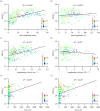Skeletal muscle function underpins muscle spindle abundance
- PMID: 35642368
- PMCID: PMC9156921
- DOI: 10.1098/rspb.2022.0622
Skeletal muscle function underpins muscle spindle abundance
Abstract
Muscle spindle abundance is highly variable within and across species, but we currently lack any clear picture of the mechanistic causes or consequences of this variation. Previous use of spindle abundance as a correlate for muscle function implies a mechanical underpinning to this variation, but these ideas have not been tested. Herein, we use integrated medical imaging and subject-specific musculoskeletal models to investigate the relationship between spindle abundance, muscle architecture and in vivo muscle behaviour in the human locomotor system. These analyses indicate that muscle spindle number is tightly correlated with muscle fascicle length, absolute fascicle length change, velocity of fibre lengthening and active muscle forces during walking. Novel correlations between functional indices and spindle abundance are also recovered, where muscles with a high abundance predominantly function as springs, compared to those with a lower abundance mostly functioning as brakes during walking. These data demonstrate that muscle fibre length, lengthening velocity and fibre force are key physiological signals to the central nervous system and its modulation of locomotion, and that muscle spindle abundance may be tightly correlated to how a muscle generates work. These insights may be combined with neuromechanics and robotic studies of motor control to help further tease apart the functional drivers of muscle spindle composition.
Keywords: MRI; biomechanics; muscle spindle; physics simulation; proprioception.
Conflict of interest statement
We declare we have no competing interests.
Figures




References
-
- Boyd IA. 1962. The structure and innervation of the nuclear bag muscle fibre system and the nuclear chain muscle fibre system in mammalian muscle spindles. Phil. Trans. R. Soc. Lond. B 245, 81-136. (10.1098/rstb.1962.0007) - DOI
Publication types
MeSH terms
Grants and funding
- BB/R016380/1/BB_/Biotechnology and Biological Sciences Research Council/United Kingdom
- BB/R016917/1/BB_/Biotechnology and Biological Sciences Research Council/United Kingdom
- BB/R017190/1/BB_/Biotechnology and Biological Sciences Research Council/United Kingdom
- MR/P020941/1/MRC_/Medical Research Council/United Kingdom
- VAC_/Versus Arthritis/United Kingdom
LinkOut - more resources
Full Text Sources

